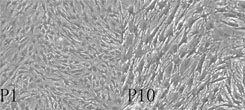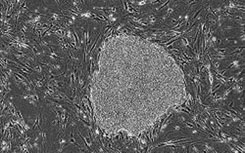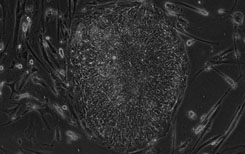Clinical-grade serum-free culture medium for stem cells
A serum-free medium and stem cell technology, which is applied in the field of clinical-grade stem cell serum-free medium and medium for cell culture, can solve problems such as batch variation, failure to maintain stem cell stemness, and imperfection
- Summary
- Abstract
- Description
- Claims
- Application Information
AI Technical Summary
Problems solved by technology
Method used
Image
Examples
Embodiment 1
[0010] A serum-free medium for clinical-grade stem cells in this embodiment uses DMEM-F12 medium as the base medium, and removes lipid components and synthetic lipid components in DMEM-F12 medium that affect cell differentiation: including Inositol and linoleic acid also contain additives, the additives and their content (final concentration) are as follows: polyvinyl alcohol 5ng / ml, BMP-410ug / ml, vitamin C 40ug / ml, retinoic acid 1uM, nicotinamide 5ug / ml, azithromycin 20ug / ml.
[0011] The specific configuration method is that when configuring the DMEM-F12 medium, no inositol and linoleic acid components are added, or the DMEM-F12 medium is degreased with activated carbon. Add the above-mentioned components to the DMEM-F12 medium that does not contain lipid components and synthetic lipid components, so that the final concentration is the above concentration, thereby obtaining a clinical-grade stem cell serum-free medium.
Embodiment 2
[0013] A serum-free medium for clinical-grade stem cells in this embodiment uses E8 medium as the basal medium, and removes lipid components and synthetic lipid components in the E8 medium that affect cell differentiation: including inositol, sub- Oleic acid also contains additives, the additives and their content (final concentration) are as follows: polyvinyl alcohol 10ng / ml, BMP-4 20ug / ml, vitamin C 15ug / ml, retinoic acid 1uM, nicotinamide 1ug / ml, azithromycin 30ug / ml.
[0014] The specific configuration method is that when configuring the E8 medium, the components of inositol and linoleic acid are not added, or the E8 medium is degreased with activated carbon. The above-mentioned components are added to the E8 medium that does not contain lipid components and synthetic lipid components, so that the final concentration is the above concentration, thereby obtaining a clinical-grade stem cell serum-free medium.
Embodiment 3
[0016] Umbilical cord mesenchymal stem cells were cultured in vitro with a clinical-grade stem cell serum-free medium obtained in Example 1, and the steps were as follows:
[0017] (1) Collection and separation of umbilical cord tissue: One umbilical cord was taken from a healthy puerpera with full-term delivery. Wash and disinfect the umbilical cord tissue in a sterile biosafety cabinet in a GMP laboratory, remove the arterial and venous vessels and the epithelial membrane tissue of the amniotic membrane, and finally obtain the perivascular tissue and Wharton's jelly tissue, which are fully shredded into 1mm3 tissue blocks. Using the tissue block attachment method, add a clinical-grade stem cell serum-free medium prepared in Example 1, inoculate it into a culture dish or a culture bottle at an appropriate density, and culture it statically in a CO2 incubator at 37°C.
[0018] (2) Subculture, observation and detection of umbilical cord MSCs: when a large number of cells crawl ...
PUM
 Login to View More
Login to View More Abstract
Description
Claims
Application Information
 Login to View More
Login to View More - R&D Engineer
- R&D Manager
- IP Professional
- Industry Leading Data Capabilities
- Powerful AI technology
- Patent DNA Extraction
Browse by: Latest US Patents, China's latest patents, Technical Efficacy Thesaurus, Application Domain, Technology Topic, Popular Technical Reports.
© 2024 PatSnap. All rights reserved.Legal|Privacy policy|Modern Slavery Act Transparency Statement|Sitemap|About US| Contact US: help@patsnap.com










